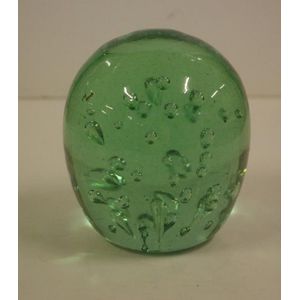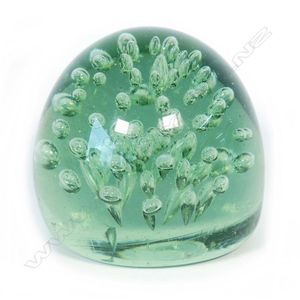Victorian Green Glass Paperweight with Bubbles
A Victorian green glass 'dump' paperweight, included with bubbles, snap-off pontil evident to base, height 7.5 cm.
You must be a subscriber, and be logged in to view price and dealer details.
Subscribe Now to view actual auction price for this item
When you subscribe, you have the option of setting the currency in which to display prices to $Au, $US, $NZ or Stg.
This item has been sold, and the description, image and price are for reference purposes only.
- Victorian Period - The Victorian period of furniture and decorative arts design covers the reign of Queen Victoria from 1837 to 1901. There was not one dominant style of furniture in the Victorian period. Designers used and modified many historical styles such as Gothic, Tudor, Elizabethan, English Rococo, Neoclassical and others, although use of some styles, such as English Rococo and Gothic tended to dominate the furniture manufacture of the period.
The Victorian period was preceded by the Regency and William IV periods, and followed by the Edwardian period, named for Edward VII (1841 ? 1910) who was King of the United Kingdom and the British Dominions and Emperor of India for the brief period from 1901 until his death in 1910. - Pontil Mark - A pontil mark, also known as a pontil scar, is a distinctive mark or scar found on the base of certain types of glass. It is a remnant of the glassblowing process and is particularly associated with handcrafted items made prior to the widespread use of automated manufacturing.
The pontil mark is created during the final stages of production. After the glassblower has shaped and formed the glass object, it is removed from the blowing iron. At this point, the glass object is often attached to a solid rod called a pontil rod or punty for further shaping, finishing, or attaching additional components. The attachment point is typically at the base of the object.
Once the glass item is complete, it is detached from the pontil rod, leaving behind a mark or scar on the base. This mark can take various forms, such as a rough or irregular surface, a concave or slightly recessed area, or a small circular scar. The presence of a pontil mark indicates that the item was handcrafted rather than mass-produced.
Collectors and historians often use pontil marks as clues to determine the age, authenticity, and production methods of glass or ceramic pieces. Different types of pontil marks may suggest different techniques used in the production process. For example, an open pontil mark is one where the scar is left as an exposed, roughened area, while a closed pontil mark occurs when the scar is smoothed or covered in some way. It's important to note that not all handcrafted glass items have pontil marks, as some artisans developed alternative methods for finishing their work. In Edwardian times the pontil mark was oftern ground off leaving a concave circle in the centre of the base of the object.
The use of pontil marks diminished with the advent of industrialization and automated manufacturing processes in the 19th and 20th centuries.
This item has been included into following indexes:
Visually similar items

Large green Majolica style charger, approx 53 cm diameter
Sold by
in
for
You can display prices in $Au, $US, $NZ or Stg.

Antique end of day dump glass paperweight 12 cm high approx
Sold by
in
for
You can display prices in $Au, $US, $NZ or Stg.

A Chelsea circular fruit and moulded berries dish, circa 1755, brown anchor mark. 24 cm diameter
Sold by
in
for
You can display prices in $Au, $US, $NZ or Stg.

An early 20th century Dutch Gouda wall plate, stylish panelled floral designs in dominant blue and mustard tones, painted marks to reverse. Diameter 31.5 cm
Sold by
in
for
You can display prices in $Au, $US, $NZ or Stg.
